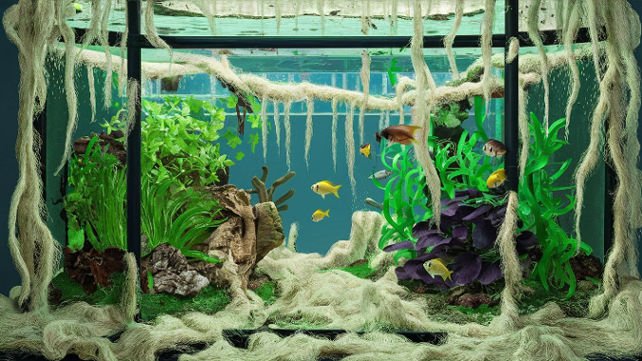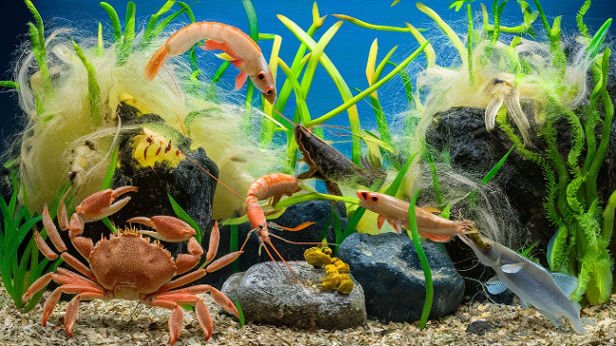Every aquarium owner’s worst fear? Waking up to find their tank overrun by white hair algae. This unwelcome guest, known as Pithophora species, quickly transforms vibrant underwater worlds into tangled wastelands. If not controlled, it spells disaster for aquatic life.
What is White Hair Algae?

Unlike spot algae growing in individual patches, white hair algae forms extensive branching strands and mats that interconnect across surfaces. These stringy, hair-like growths cling tenaciously to decorations, equipment, substrate, and aquatic plants, waving menacingly with the water currents.
As the thick mats accumulate, they can:
- Restrict water flow
- Block light from reaching plants
- Cause oxygen depletion due to decaying biomass
Your once-beautiful underwater oasis transforms into a tangled mess, leaving you wondering where it all went wrong.
What Triggers Rapid Growth?
While algae spores naturally exist in aquarium water, specific conditions can trigger an explosive bloom of white hair algae:
- Excess Nutrients: High iron (>0.5 ppm) or phosphate levels (>2 ppm) provide excess nutrients that fuel algae growth, often from overdosing liquid fertilizers or overfeeding.
- Poor Maintenance: Skipping water changes and filter cleanings allows dissolved organics and nutrients to accumulate, creating an ideal environment.
- Excessive Lighting: Prolonged or intense lighting can stress plants, causing them to release organics that sustain the algae.
- Low CO2 Levels: Inadequate carbon dioxide leads to underperforming plants, again providing organics that feed the algae.
Prevention is crucial, but if you find yourself battling an infestation, it’s time for an aggressive, multi-pronged attack.
The Multi-Pronged Attack Strategy
1. Manual Removal
While tedious, manually removing as much visible white hair algae as possible is the first step. Use an old toothbrush, tweezers, or other tools to carefully detangle and lift away the algae during weekly water changes. Focus on decorations, plants, and accessible equipment surfaces.
During removal, reduce the main light duration to 6 hours daily to slow regrowth. Consider removing heavily infested decorations and plants or re-aquascaping the tank if the algae persists.
2. Enlist Some Help
Introducing natural predators can be an effective biological control method. Algae-eating species like:
- Siamese Algae Eaters
- Amano Shrimp
- Otocinclus Catfish
- Nerite Snails
- Twig Catfish
…can assist in managing algae levels. However, they shouldn’t be the sole solution.

3. Adjust Water Chemistry
Test aquarium water with master test kits or individual phosphate and iron tests to identify imbalances allowing white hair algae to thrive. Cease dosing any supplemental liquid fertilizers until nutrient levels normalize.
Add activated carbon or phosphate-specific media like Phosguard to remove excess phosphates and organics. Dial in carbon dioxide injection rates between 25-35 ppm using a drop checker and pH controller. This suffocates algae while ensuring adequate CO2 for healthy plants.
4. Use Algaecides (With Caution)
For stubborn infestations, specialty algaecide treatments containing antibiotics or hydrogen peroxide can accelerate progress when used properly. Choose aquarium-safe, copper-free products and closely follow dosing and water change instructions.
Always quarantine or remove invertebrates like shrimp before using algaecides. Conduct additional water testing after treatments and use conditioners to remove medication residuals before reintroducing sensitive species.
Preventing Future Outbreaks
To sustain plant growth while starving nuisance algae:
- Automate Lighting: Run lights on an 8-hour maximum photoperiod using an automatic timer to prevent light excess.
- Upgrade Filtration: Add a canister filter or second hang-on-back model to enhance nutrient export through increased flow and turnover.
- Feed Less: Don’t overfeed fish, as uneaten food spikes phosphates and nitrates.
- Fertilize Strategically: Dose aquarium plant fertilizers based on test kit results, not a fixed schedule.
Staying vigilant on maintenance and properly balancing lighting, CO2, and fertilization fosters lush plant growth that outcompetes problematic algae.
Step-by-Step Guide: Adjusting Water Chemistry
Addressing water chemistry imbalances is crucial for controlling white hair algae. Here’s a step-by-step guide:
- Test Water Parameters: Use a reliable test kit to measure iron, phosphate, nitrate, and other key parameters.
- Identify Imbalances: Compare results to recommended levels (iron <0.5 ppm, phosphates <2 ppm).
- Stop Fertilizer Dosing: Pause any liquid fertilizers contributing to excessive nutrients.
- Remove Excess Nutrients:
- Add activated carbon or Phosguard to filter
- Perform larger than normal water changes
- Dial in CO2 Levels: Use a drop checker and pH controller to maintain CO2 between 25-35 ppm.
- Monitor and Adjust: Retest parameters weekly and make adjustments as needed.
Consistent water testing and making the necessary corrections are vital for regaining control over white hair algae.
Preventative Maintenance Schedule
Implementing a preventative maintenance routine is key to keeping your aquarium healthy and algae-free:
- Weekly:
- 25% water change
- Clean filter media
- Test water parameters
- Monthly:
- 50% water change
- Rinse filter media in tank water
- Trim/remove dead plant matter
- Quarterly:
- Replace filter media
- Deep clean tank glass and decorations
By staying proactive with maintenance and using high-quality test kits like the API Freshwater Master Test Kit, you can catch imbalances early and make necessary adjustments before algae takes hold.
Battling white hair algae takes persistence, but the reward is a vibrant, algae-free planted tank you can truly enjoy. Have you conquered this pesky algae? Share your tactics and experiences in the comments below!
Struggling to keep algae at bay? Subscribe to our newsletter for more expert aquarium care tips and maintenance guides!

